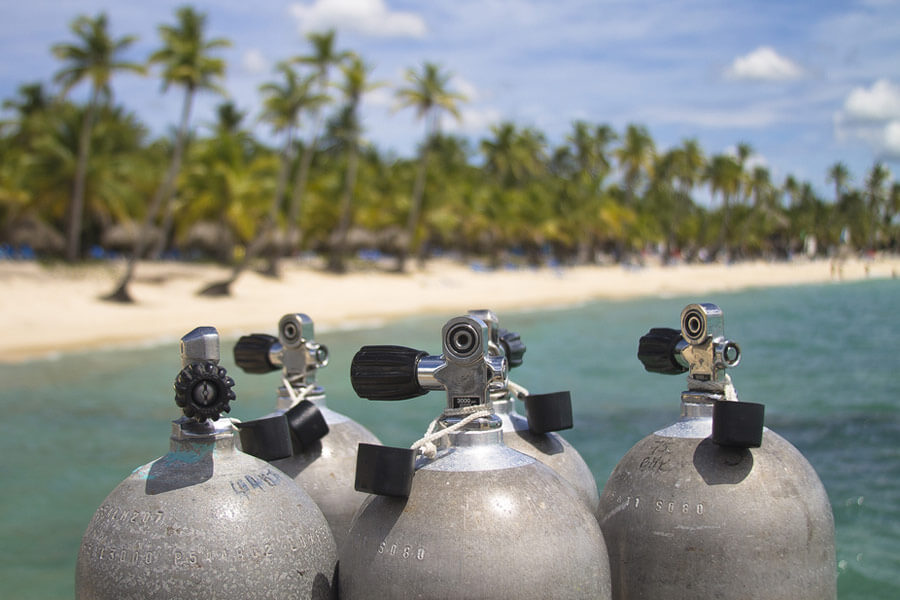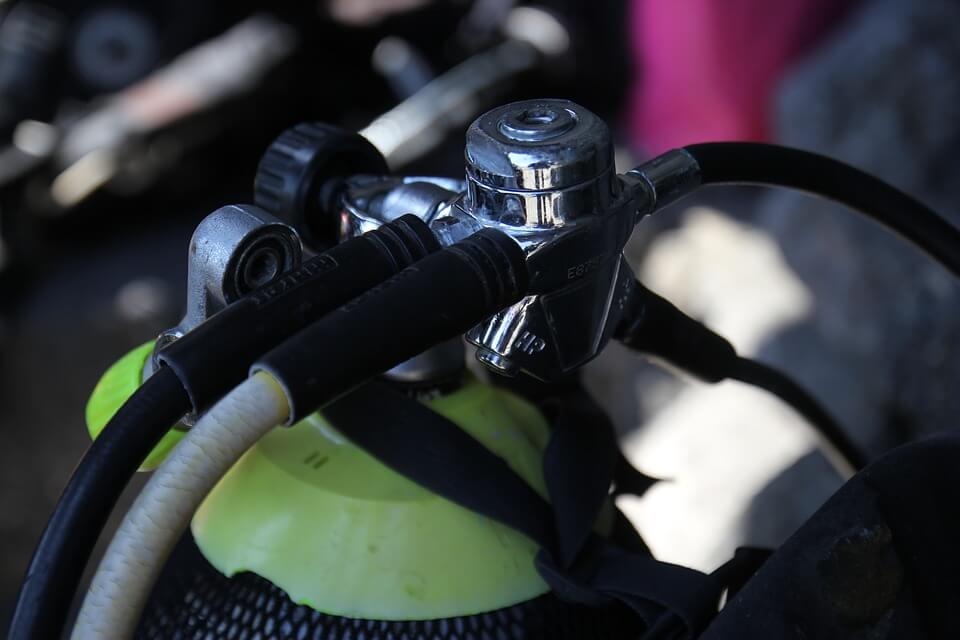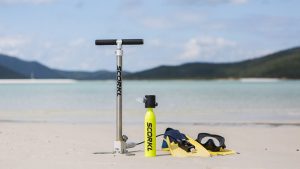Buying the right aluminum or steel scuba tank for diving is the first step to having a successful diving vacation. However, this is easier said than done. There are so many things to consider to have the best one.
Being able to breathe while you are underwater is crucial to scuba divers because it allows them to extend their dives. Scuba diving tanks are therefore an important component of the dive gear for that particular purpose. These tanks also come in very handy when a there is an emergency while diving and a diver urgently need oxygen; they can help save a life.
Scuba divers have several options of having a scuba diving tank that include buying a brand new tank, buying a used one or hiring one. In the three options, these tanks come in different styles and sizes and it is thus very important to choose one that is best suited for you.
Below is a basic guide of what every diver should consider before buying a scuba tank.
You May Also Like :
Aluminum and steel scuba tank sizes

The size of a scuba diving tank will determine its capacity, which is an important consideration. The capacity of any tank is measured in pressurized cubic feet. The most popular tank size that is used by recreational divers is the ones that hold 80 to 100 cubic feet of air.
There are however smaller tanks, but the reason that this size range is more common is because they are able to provide sufficient air to most divers without them being in risk of reaching the no decompression limits. In addition, these tanks are cheaper and thus divers can buy them in bulk. It is advisable to carry a pony tank (usually 40 fee and below) in addition to the main tank in case the main one develops a fault.
For younger or shorter divers and those who are learning how to dive, smaller tanks of 63 cubic feet are a more popular choice since they tend to do short and shallow dives and the tanks are not uncomfortably tall for them. For divers who spend longer times under water and the ones that consume a lot of air, they should consider diving with bigger tanks of 100 to 130 cubic feet.
Aluminum versus Steel scuba tank
Scuba diving tanks are usually made of aluminum or steel. Before selecting either of the two, it is important to know their fundamental differences.
Aluminum scuba tanks
They tend to shift from negative buoyancy to positive buoyancy as the diver consumes the oxygen. This means that in order for the diver to be properly weighted at the end of the dive, he might require to carry extra weight at the beginning of the dive.
They are less sturdy when compared to the steel ones and they are a bit soft than steel which makes them more likely to be damaged and to suffer dents. However, when it comes to pricing, aluminum tanks are less costly and they do not get rust; even if water happens to get inside the tank, it will not suffer any corrosion whatsoever. These makes them better fitted salty water dive tanks.
Steel scuba tank
These tend to be heavier than the aluminum tanks and thus the diver will be required to wear less weight when using them. Due to this reason, they shift from negative buoyancy to positive buoyancy as the diver consumes the air.
Therefore, a diver will still be properly weighted even at the end of the dive. If proper maintenance is taken on the steel tanks, they can last much longer than the aluminum ones.
However, they tend to rust very fast and if water gets inside the tank and it is left unattended, it can cause severe and irreparable damage due to oxidation and corrosion.
Low Pressure vs High Pressure scuba tanks
The pressure of a scuba tank is measured in Pounds per Square Inch (PSI) or Bar. The pressure in dive tanks mostly range between 2400PSI-3500PSI or 165-240 Bar.
High-pressure tanks that range between 3300PSI-3500PSI are much smaller and they contain high amounts of air. They also need a regulator set up for DIN, frequent part replacement and servicing since they are subjected to very high amounts of pressure.
Low-pressure tanks on the other hand are much easier to handle, their pressure range between 2400 PSI – 2700PSI, and they do not require to be serviced as frequently as their high-pressure counterparts do.
Yoke vs DIN Valve fittings?
There are two types of valve fittings used to fit the regulator on the tank – Yoke and DIN. Valves are also an important component in a scuba tank since they control the amount of air that flows from tank to the regulator.
Yoke valves are the most common, they are mostly used in the aluminum 80 scuba tanks, and they are the simplest to use. DIN valves are on the other hands much safer than the yoke valves and they are the only ones that blend well with high-pressure tanks.
A diver should occasionally check if the valve is loose or too hard to turn. In case of either of the two cases, the tank will require a service. In addition, a diver should also check if the valve leaks. The easiest way to check for leaks is by submerging the tank in water and check for bubbles. If bubbles are present, it means that the tank is leaking.
Compatibility with Oxygen

Before buying a scuba tank, it is good to ascertain the oxygen compatibility. Some manufactures make scuba tanks that are only to use with air (20.9% oxygen).
Divers who require higher percentages of oxygen such as Nitrox have to buy the ones that are compatible with higher oxygen percentages and the valve has to be labeled as both oxygen compatible and cleaned for oxygen service.
Used scuba tank
What do you look for when buying a used diving tank?
Buying a used diving tank is a good alternative since it can save you a considerable amount of cash. However, it can be very tricky because you are buying something that you are not very sure of and that is why a diver should be very cautious when buying a used tank.
Here are some steps that you should follow when buying such a tank to ensure that it is worth every penny you spend on it.
The first thing you should do is ensure that the tank is not out of the test. Inquire from the person who is selling the tank the reason why he wants to sell it and how he used to use and store it.
From the information the seller will give you, you will be able to gather some insights about the tank. For instance, if he mentions that he used to store the tank in a garage; that should tell you that the tank might have developed some faults due to damp conditions.
Do some visual inspections on the tank to check if it has any signs of external damage. Such signs includes, dents, rust and deep scratches. When doing the inspection, make sure that you remove the boot if it is fitted and check thoroughly for any damage.
Check the valves too for any damage. Since they are made of brass, any damage should be easily noticeable. If the tank portrays such external damages, it is not advisable to spend your money on it.
It is very important that you know the material that makes the tank, which the seller should also disclose to you. As we said earlier, two main materials make scuba tanks – aluminum and steel. Steel tanks when serviced regularly are more durable than the aluminum tanks.
Ascertaining whether the tank has any internal problem is quite hard but one of the easiest ways of doing so is by checking if it has some air pressure in it. A tank with some air inside is not likely to have internal problems. This is because when it is full with air there is no room for moisture that causes the tank to rust.
Check for the last service date on the visual inspection sticker and see whether it is current. A sticker with a current date will tell you that the tank used to be regularly maintained.

Check whether the valve of the tank is compatible with your regulator first stage attachment. Most of the tanks use a yoke or K-valve so that the regulator can slip and lock in place on its first stage attachment. Some use DIN valve but they require a special screwed initial stage.
Check if the valve is opening smoothly without any hitches. If it is stiff when opening, it is an indication that it needs to be serviced and if it does not open at all, it shows that may need to be replaced. Additionally, check if it is leaking by attaching the regulator setup to the tank, smell from the regulator to detect any unusual smell.
Take the tank to a local dive shop for hydrostatic and physical testing to be sure that it is working properly. A good dive shop attendant should be able to advise you whether it is prudent to buy it or not.
Scuba tank prices
Finally, remember to check the steel scuba tank prices. However, when you are down there in the bowels of the ocean depending on your tank to keep you alive, you will not worry much about the price. Just make sure that you have the best tank for diving, and no matter how much you pay for it, you can be sure you will get more than enough value for money.






